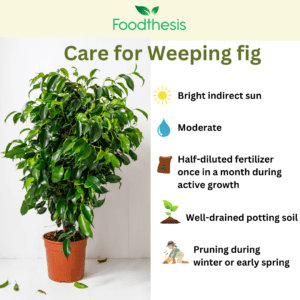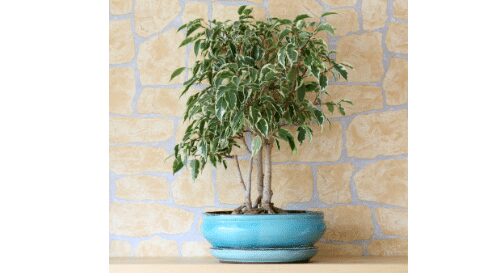Care for Weeping fig facts
|
Introduction
Weeping fig (Ficus benjamina) is an evergreen tree or shrub, belonging to the family Moraceae. The following article is all about how to take care of weeping figs and other descriptions. This plant is famous for its narrow, pointed glossy green leaves that grow as an indoor as well as an outdoor houseplant.
Common Name
Weeping fig, ficus tree, benjamin fig, weeping fig tree, golden fig, Java fig, fico-chorao, tropic-laurel, and Chinese banya
Geographical distribution
The weeping figs are native to India, southern China, Southeast Asia, Malaysia, the Philippines, northern Australia, and the islands of the South Pacific
Botanical description
Height
This weeping fig can grow up to 50 feet (15 m) outdoors and 3 to 6 feet tall when grown indoors. It is a slow-growing plant, so you can easily grow this plant indoors because it takes many years to reach this tree-like size.
Leaves and stem
Leaves can be a shiny dark green light green or creamy white and become darker green as the plant ages. The stem is light gray, tall, slender, and sometimes braided for decorative purposes (1).
Flower
This plant produces creamy white to yellowish flowers in summer only when grown outdoors.
Fruits
The fruit is edible, orange, red, pink, or purple, and is produced on the tree throughout the year. Whereas this plant usually does not bloom or fruit indoors (2).
Weeping fig care

Taking care of a weeping tree is very important as it has a common problem of losing leaves under stress. Therefore, appropriate light, water, soil, pruning, and fertilization are essential for a healthy plant. This plant care is fairly easy and proves best for indoors when you know how.
1. Temperature
Weeping fig plants can tolerate temperatures between 50-85°F (10-29°C). Daytime temperatures of around 75- 85 °F (24-29°C) and nighttime temperatures between 65-75 °F (18-24°C) are ideal for its growth.
2. Light
This plant needs bright, indirect light or direct light in the morning hours (3–4 hrs/day).
For indoors, it can be placed near a sunny window, and for outdoors, partial shading is necessary.
Side effects of low light
Find a good, bright spot because low light will drop off all its leaves or lose their variegation. Apart from this plants dislike being moved so select a convenient spot where you won’t need to move it very often.
3. Water
This plant requires water in a moderate amount when the top few inches of soil are dry. Water thoroughly, then allow the soil to dry slightly between watering.
Besides, this plant is very sensitive to chemicals found in tap water like chlorine and fluoride. Therefore, to avoid its harmful effects, use only distilled or filtered water. If you don’t have filter water, you can leave a jug of tap water out overnight so chemicals like chlorine disperse. Apply less water during the winter dormant period
Side effects of overwater and underwater
Over-watering and under-watering may cause yellow-brown spots, and loss of the leaves, and may develop root rot. So regular checking of soggy soil or too dry soil is necessary.
4. Soil
Well-drained potting soil is best, to avoid root rot of these plants.
5. Repotting
This plant is slow-growing and likely to be a little pot-bound so does not require repotting often. However, the reporting of young plants should be done every year. The best time for repotting is the beginning of spring which moves the plant into a pot one size larger.
6. Fertilizer
Although weeping fig plants are friendly and easy to grow, they still need a lot of attention and care. Fertilize about once a month with standard half-diluted fertilizer. Suspend fertilizing during the dormant winter period.
7. Humidity
Weeping fig plants grow well in very high humidity (50 -70 %) so you can regulate humidity levels by a cool-mist room humidifier.
8. Pruning
Prune the weeping fig plants necessary to maintain their size, remove old leaves, and keep branches strong. Cuttings can also be rooted simply by inserting the ends in the soil. The best time for pruning is in the winter or the beginning of spring
Weeping fig propagation
It is a wonderful plant that can grab people’s interest to grow as indoor as well as outdoor plants. But there are a few questions that arise about how to propagate these amazing plants.
The weeping fig plants can be easily propagated using stem cuttings (only non-woody) and replanted in potting soil in spring. Mist and spray the soil surface until the roots are growing out.
Weeping fig indoor air purifier
Weeping fig plants can clean the indoor air from harmful chemicals such as formaldehyde, toluene, xylene, and hydrocarbon. These pollutants may irritate the nose, mouth, and throat, swelling the larynx and lungs (3).
Weeping fig toxic to cats or dogs
Weeping fig contains toxic compounds, like ficin, furocoumarins, and ficusin. These compounds may cause gastrointestinal and dermal irritation to cats and dogs. When they accidentally consume this plant, it may result in nausea, vomiting, and diarrhea (4).
Side effects of weeping fig plant on humans
- Weeping fig plants contain milky irritating sap (latex) in the stems and leaves which cause skin irritation when exposed to skin cuts (5).
- A person who is allergic to latex should avoid getting the latex liquid on their skin (6). Because it may cause anaphylactic shock (severe allergic reaction) in extreme conditions (7).
- It also causes rhinoconjunctivitis and allergic asthma in humans (8).
- In some occupations such as gardeners, it can induce contact urticaria (swelling and redness). angioedema (swelling) and pruritus (irritation sensation) (9).
Weeping fig medicinal value or health benefits
- Weeping fig contains some bioactive compounds such as laxative substances, flavonoids, sugars, vitamins A and C, and enzymes.
- These nutrients show antimicrobial, antinociceptive, antipyretic, hypotensive, and anti-dysentery properties.
- In some parts of the world, its leaves and fruit extract are used by indigenous communities to treat skin and respiratory disorders.
- It is also used for the treatment of inflammation, piles, vomiting, leprosy, malaria, nose diseases, and cancer.
- Besides its use as a general tonic, its leaves and twigs are used as insect repellant (10).
- Possible antimicrobial and antioxidant properties– Weeping fig leaves contain a high amount of polyphenolic compounds. These compounds fight against Mycobacterium smegmatis, Pseudomonas aerugonisa, Escherichia coli, Bacillus subtilis, and Bacillus cerus. It also inhibits the growth of fungi like Aspergillus niger and Candida albicans thus preventing its infection (11).
Moreover, these phenolic compounds also increase the antioxidant defense system. Thus protects the body from several clinical disorders such as diabetes mellitus, cancer, renal failures, and degenerative diseases (12)
Q&A
How much light does a weeping fig need?
Weeping figs need direct sunlight in the morning hours (3–4 hrs/day) near the window for indoor and outdoor partial shading is necessary.
How big does a weeping fig get?
Weeping fig plants can grow up to 50 feet outdoors and 3 to 6 feet tall when grown indoors. To keep this plant in a bonsai format pruning is necessary.
Why are the leaves falling off my weeping fig?
Weeping fig are sensitive to changes in their environment, sudden changes in location may cause yellowing and dropping leaves. Wide changes in temperature, waterlogging, or over-fertilization may also cause leaf drop. Furthermore, this plant is also susceptible to disease, and aphids or spider mites infestation begins to drop its leaves. Thus, perfect growing conditions are helpful to prevent further stress.
How do you care for an indoor weeping fig tree?
Weeping fig plants need morning sunlight, well-draining soil, and water only when the top inches of the soil are dry. It requires fertilizer during the growing season, and drastic pruning to control its size. Also avoid cold drafts, dry heat, and sudden temperature changes.
